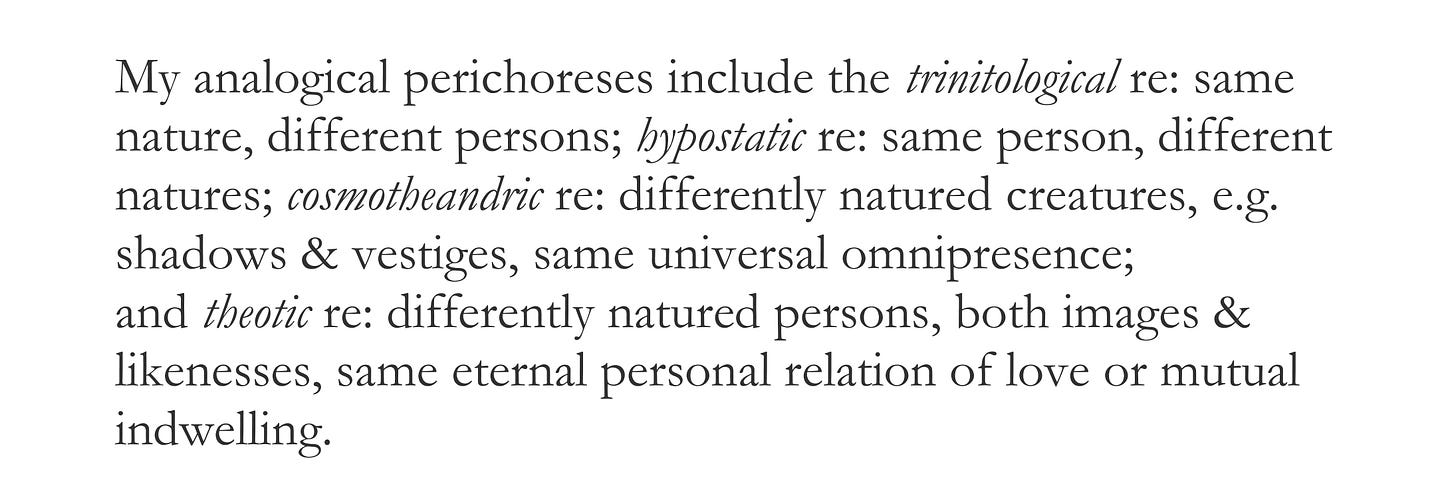All Persons are Constituted by Both Acts & Relations, Subjectively & Intersubjectively, Quidditatively & Expressively
All persons are constituted both subjectively & intersubjectively, which is to say, by both their entitative acts & their interpersonal relations.
Metaphysically, these subjective acts & intersubjective relations are, constitutively, equiprimordial.
Entitative acts are variously self-determinative.
Per the primacy of persons, paterologically, the Father self-determines, ur-kenotically, both the divine essence & divine relations (Otherings or Thounesses).
Christologically, the Son self-determines, kenotically, both His secondary essence – His ex Deo human nature – & His cosmotheandric relations (otherings or thounesses).
Anthropologically, we co-self-determine – not our primary nature, as Christ-images, but – our secondary natures, as Christ-likenesses, by how we kenotically & synergistically manifest, expressively, what we are, constitutively.
The kenotic self-transcendent dynamic that constitutively orders all subjects, “what“ever their primary natures, to intersubjective relations, situates all persons on transcendental horizons, which is to say, open to the emergent intersubjective novelties that will emerge from “how” each person co-self-determines to express their love.
These horizons & novelties represent analogous ad intra & ad extra divine perichoreses, which per an emergentist logic are not quidditatively reducible in constitutive terms of “what“nesses. Their intelligibility derives, rather, from the distinct “how“nesses by which each person uniquely manifests “what” they are and so reveals “who” they are in the context of their intersubjective relationality.
In emergentist accounts of determinate being, both the existential acts that reduce essential potencies of whatness (primary natures) and efficient – formal acts (volitional or will – intellect) that reduce im/material & final potencies of howness (secondary natures) are dynamical. This is to say that, phylogenetically, essences can evolve and that, ontogenetically, individuals can evolve in how they manifest their received (static) primary natures in intersubjective contexts. This is to recognize that, while “what” one is, quidditatively, has been determined, “how” one is, expressively, remains decidedly probabilistic. This is to say that, modally, noncontradiction holds but excluded middle folds, which means that our range of theophanic final potencies has been divinely determined, while our specific efficient – formal or volitional acts have not. This very much brings to mind how I understand Tom Belt’s Open account.
By properly prescinding from pure necessity to probability for determinate being, we can avoid the pseudo-tensions that arise from the false dichotomy of essentialism & nominalism, which represents the obverse sides of the same bankrupt epistemic – ontic coinage. It’s precisely such a pseudo-tension in play between Báñezian & Molinist accounts of nature, grace & freedom, all realities which present in terms of – not all or nothing & either – or, but – degrees & intensities, ranges & scopes and types & extents.
While any given person, subjectively & entitatively, has a determined primary nature as gifted per the gratuity of creation, grace operates per one’s expressive secondary nature, which is synergistically co-self-determined probabilistically.
In an emergentist metaphysic of intersubjectivity, entitative subjective whatnesses are determined within discrete but integrally related hierarchical levels, i.e. per similar horizontal causes (existential acts reducing essential potencies) and unique personal hownesses are expressed relationally in all manner of discrete intersubjective novelties. Because those personal hownesses are volitional, they are synergistically co-self-determined per distinct, but simultaneous, vertical causes (formal acts reducing final potencies). Persons thus become increasingly open to further influences (e.g. obediential potencies) by higher hierarchical levels (e.g. uncreated prevenient graces).
The analogous perichoreses – Trinitological, Christological, Cosmotheandric & Theotic – all also have analogous horizontal (natural) & vertical (volitional) causation dynamics, which vary per nondeterminate, self-determinate & variously in/determinate beings. It’s precisely per the simultaneity of these analogous vertical causes (per their respective horizontal hierarchies) that our emergentist accounts of emanation & generation, ur-kenosis & kenosis, can block such inferences as proto-Father, Paterologically, Logos asarkos, Christologically, and natura pura, cosmotheandrically.
This is all to point out that Jordan Daniel Woods’ defense of Bonaventure’s emanation account and his Maximian Christological Cosmology, Lonergan’s conception of vertical finality (levels of consciousness, scale of values & divine relations analogies), Yong’s Cosmic Spirit (pneumatological theology of religions) and Bracken & Gelpi’s metaphysics of intersubjectivity (Divine Matrix, theology of conversion & narrative Maximian Christology) are in many ways, variously explicitly & implicitly, consistent with Peirce’s phenomenological modal ontology & pragmatic semiotic realism. I recommend it as a very felicitous idiom for any systematics.





